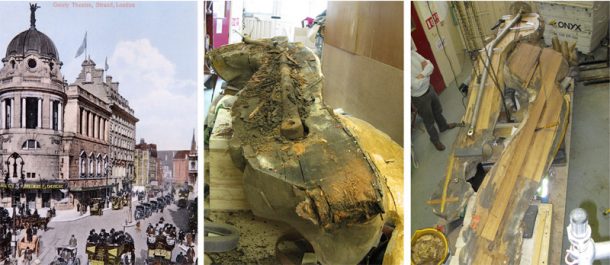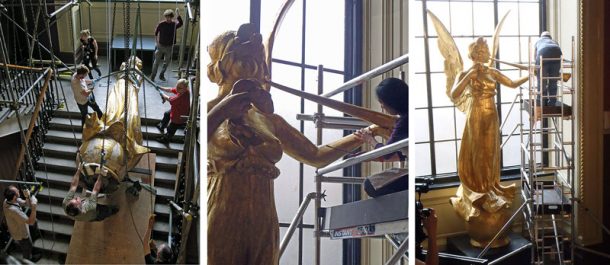by Zoe Allen, Head of Furniture Conservation, and Yukiko Yoshii Barrow, Frame and Furniture Conservator
The carved and gilded Spirit of Gaiety angel (S.2630-1986) was made by the sculptor Hibbert C Binny in 1904 to stand on top of the dome of the second Gaiety Theatre in London, which formerly stood at the junction of Aldwych and the Strand. The figure, measuring 4500mm high by 2200mm wide, is made of blocks of carved teak held together by an internal metal armature. The theatre was demolished in 1957 but fortunately the angel was not destroyed; the sculpture was removed and preserved in the well of the Citibank building which was built on the same site. In 1984 the angel was presented to the Theatre Museum in Covent Garden by its joint owners and displayed in the main entrance until 1992 when, due to concerns regarding its condition, it was taken off of display and moved into storage at the Victoria & Albert Museum. It is extremely rare for wooden architectural sculpture to survive. Due to the size and weight of these figures, and the deterioration they suffered through exposure to the elements, they are seldom preserved intact when the buildings they surmount are demolished. The V&A’s angel is likely to be unique within UK museum collections.
During its 50 years on the dome of the theatre, rain water had penetrated to the sculpture’s core and the internal supporting ironwork became heavily corroded causing internal wood to rot and weaken. Urgent treatment was required to prevent eventual collapse. Funds were raised for conservation to be carried out and in 2010 the angel underwent a first phase of extensive structural treatment by Plowden and Smith Limited. The sculpture was x-rayed to understand more accurately how it was constructed. The information gained allowed the safe removal of the wings and arms and the original joints were identified to enable the figure to be split into two halves. Once opened up, the severely rusting internal armature, consisting of a central ferrous post and six lateral bolts, was removed and replaced with a new stainless steel support made by V&A technicians. Rotting timbers were consolidated with Paraloid B72 in acetone. Where consolidation was not possible the wood was removed and replaced with new sections of iroko wood. After treatment the two halves were re-joined with four new lateral stainless steel bolts and gaps were filled with Flugger acrylic filler. No treatment to the gilded surface was carried out other than protecting the surface edges with facing tissue of Japanese paper and starch paste (Figure 1). The sculpture was then transported back to the V&A and displayed at the end of The Edwin and Susan Davies Galleries (Rooms 81 and 82).

i. Post card of Gaiety Theatre Strand, 1903 (image purchased from Alamy Limited)
ii. The internal supporting ironwork became heavily corroded causing internal wood to rot and weaken, 2010 © Plowden & Smith Ltd, London
iii. New stainless steel support inserted by Plowden & Smith Ltd, Conservation London, 2010 © Plowden & Smith Ltd, London
In 2016 a second phase of conservation began to treat the gilded surface in situ. The surface had undergone several campaigns of repair in the past consisting of consolidation, filling and protecting the surface with facing tissue but only two of these interventions were recorded. In 1987 work was carried out at the Theatre Museum by Malcolm Green (V&A Gilding Conservator until 1993) to prepare the sculpture for the Theatre Museum’s opening in April 1987, and in 1992 further treatment was carried out prior to its removal from the Theatre Museum to storage. When work began in 2016, approximately 80% of the surface was covered with the protective facing tissue applied during the last two conservation treatments to prevent the surface gilded decoration from de-attaching, one carried out in 1992 with eltoline tissue and Rhodoviol 4/12 (PVA adhesive) and the other in 2010 using starch paste. Surface dust was removed from the entire surface with soft brushes and a vacuum. Tests carried out established that the best method for the removal of each phase of facing tissue was deionized water applied with a brush over the tissue then carefully removed with a stiffer brush. Tissue applied with starch paste was removed very easily, while some areas with tissue applied with Rhodoviol were more stubborn so were removed with lukewarm deionised water brushed on the surface and left for longer when necessary.
Under the tissue, large areas of the gilded surface were blistering and delaminating from the wooden substrate. There was also lifting and flaking between the painted and gilded layers. These areas needed to be re-fixed and this process often needed to be carried out at the same time as the tissue removal. Depending on the area and nature of delamination, the consolidation product used varied. For flaking gilding, Lascaux 4178 was used and for thicker delaminating layers, 20% rabbit skin glue was used. For areas delaminating from the wooden substrate, Lascaux 360/ 498 was used in conjunction with a heated spatula.
Some more brittle areas of lifting were humidified first by brushing the surface with deionized water before applying the consolidant beneath the lifting surface. Wet tissue (Tork heavy duty cleaning cloth) was placed over the area to be consolidated and ‘ironed’ on top. This effectively steamed the lifting surface, kept the temperature lower than 100°C and softened the layers, allowing them to fit back into position to follow the sculptured shapes of the statue.
Below the facing tissue the surface was quite dirty where surface dust had become ingrained with dirt in the layer of rabbit skin glue that had been applied to the whole surface in 1987. The surface was patchy with several areas of old retouching in ochre-coloured acrylic and bronze paint and there were also areas of residue from the Rhodoviol 4/12 (PVA) adhesive. After consolidation, the surface was cleaned with deionized water. Discoloured bronze paint was removed with an alkaline glycerol solution of 120g sodium hydroxide (caustic soda), 40 ml glycerol, 2L deionised water then rinsed with a weak acidic solution of acetic acid in deionised water PH 3.2-3.4. A Tork heavy duty cleaning cloth was used during the cleaning process.
After tissue removal the extent of losses to the gilded surface could be established. There were approximately 20% of visually disturbing losses to the surface, exposing the wood below. The surface was coated with an isolation layer of a 10% solution of gelatine. Tests were carried out to find a filler which would allow some future movement in the sculpture. Pigmented Flugger and gesso produced cracks on drying and Flugger is not so easily reversible. Microballons with 10% rabbit skin glue pigmented with yellow ochre to match the base color under the gilding produced the best results. This filler is easy to reverse and once dry, the surface could be easily shaped and smoothed. Open construction and stepped joints were shallow filled in such a way as to show the original construction but to give an overall unity.
Existing fills from previous treatments (1987 Tetrion, 2010 Flugger) were shaped and re-worked to to replicate the texture of the surrounding area. Fill material which had been applied over the gilded surface was carefully mechanically removed. These previous fills were painted an ochre base colour. All fills were sealed with gelatin and gilded with 12 hour oil size Charbonnel Mixtion and gilded with 23.5ct Triple Thick Transfer Gold Leaf (lightly presses) from Wrights of Lymm Ltd.
When new gilding is applied it is very bright so a process known as distressing and toning is carried out to dull down the gold to match the surrounding area. Distressing was carried out with stiff brushes and abrasive sponges. The gilded surface of the angel is quite mottled and rough due to the years of exposure. Furthermore it is not likely to have ever had a perfect finish as it was not meant to be viewed from close up. Our distressing aimed to imitate this finish. Toning was carried out with rabbit skin glue pigmented with Shminke watercolours plus one drop of Primal to break the surface tension and watercolours (Figure 2).

i. Installation of the angel at the V&A, 2010
ii. Conservation of gilded surface in situ, 2016
iii. Treatment completed and dismantling of scaffold, 2017
During conservation close visual examination of the surface showed that the present gilded surface is not original. Earlier decorative schemes were visible and surprisingly silver could be seen in areas. Through cross-section analysis, four earlier decorative schemes have been identified:
- The earliest visible scheme (Figure 3(i)) is made of gold-coloured filings. Their appearance suggests that they are made of bronze or brass paint.
- The second scheme (Figure 3(ii)) is made of finely divided, silver-coloured metal paint.
- The third scheme contains a barely visible, corroded layer of silver-coloured leaf.
- And finally the fourth scheme, which is what gives the current golden appearance to the Angel, looks like it contains gold leaf.

i. Pre-treatment image of the base, 2009
ii. Removing facing tissue, one half, 2016
iii. Losses filled, 2017
iv. Losses gilded, 2017
v. New gilding distressed and toned, 2017
We know at some point in its life the sculpture was silver in colour but no records exist of when this happened. As it started out golden in appearance it was decided to leave the current scheme but having the information at hand opens the avenue to further possible research regarding its history. In her new splendour, the angel is now visible to many visitors and the joy and gaiety she represents (blowing through her trumpet) can be appreciated once more.
The Spirit of Gaiety was given by Citibank, its landlord The Prudential Assurance Company, and the Greater London Council.



I believe there is or was a Gaiety Theatre in Japan ?
I am interested in contacting groups who enjoy the memories etc of the Gaiety Theatre that was in London.
I have a first edition book to sell written by W McQueen Pope and within its pages is a hand script letter to a Kay Dickinson who obviously had an input into the Theatre. Pope sent her a first edition of this book dated 1949 and signed. The book is in good to fair condition with all pages intact. Should anyone be interested in making me an offer for this book please go to trademe.co.nz searching in Books for Gaiety Theatre of Enchantment.